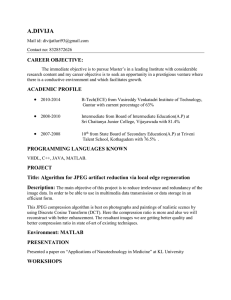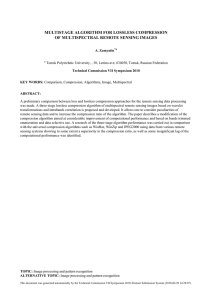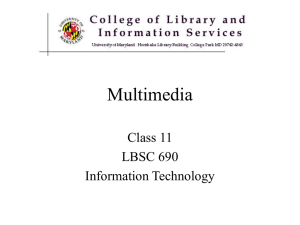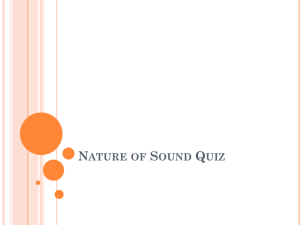Research Journal of Applied Sciences, Engineering and Technology 4(24): 5381-5386,... ISSN: 2040-7467
advertisement
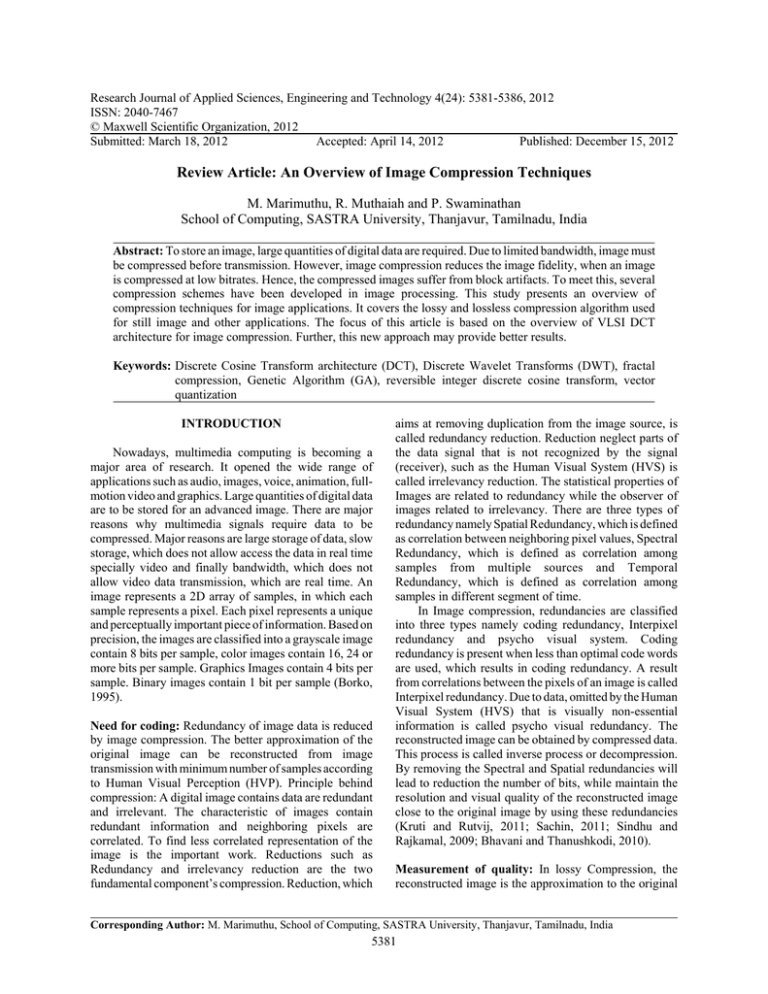
Research Journal of Applied Sciences, Engineering and Technology 4(24): 5381-5386, 2012 ISSN: 2040-7467 © Maxwell Scientific Organization, 2012 Submitted: March 18, 2012 Accepted: April 14, 2012 Published: December 15, 2012 Review Article: An Overview of Image Compression Techniques M. Marimuthu, R. Muthaiah and P. Swaminathan School of Computing, SASTRA University, Thanjavur, Tamilnadu, India Abstract: To store an image, large quantities of digital data are required. Due to limited bandwidth, image must be compressed before transmission. However, image compression reduces the image fidelity, when an image is compressed at low bitrates. Hence, the compressed images suffer from block artifacts. To meet this, several compression schemes have been developed in image processing. This study presents an overview of compression techniques for image applications. It covers the lossy and lossless compression algorithm used for still image and other applications. The focus of this article is based on the overview of VLSI DCT architecture for image compression. Further, this new approach may provide better results. Keywords: Discrete Cosine Transform architecture (DCT), Discrete Wavelet Transforms (DWT), fractal compression, Genetic Algorithm (GA), reversible integer discrete cosine transform, vector quantization INTRODUCTION Nowadays, multimedia computing is becoming a major area of research. It opened the wide range of applications such as audio, images, voice, animation, fullmotion video and graphics. Large quantities of digital data are to be stored for an advanced image. There are major reasons why multimedia signals require data to be compressed. Major reasons are large storage of data, slow storage, which does not allow access the data in real time specially video and finally bandwidth, which does not allow video data transmission, which are real time. An image represents a 2D array of samples, in which each sample represents a pixel. Each pixel represents a unique and perceptually important piece of information. Based on precision, the images are classified into a grayscale image contain 8 bits per sample, color images contain 16, 24 or more bits per sample. Graphics Images contain 4 bits per sample. Binary images contain 1 bit per sample (Borko, 1995). Need for coding: Redundancy of image data is reduced by image compression. The better approximation of the original image can be reconstructed from image transmission with minimum number of samples according to Human Visual Perception (HVP). Principle behind compression: A digital image contains data are redundant and irrelevant. The characteristic of images contain redundant information and neighboring pixels are correlated. To find less correlated representation of the image is the important work. Reductions such as Redundancy and irrelevancy reduction are the two fundamental component’s compression. Reduction, which aims at removing duplication from the image source, is called redundancy reduction. Reduction neglect parts of the data signal that is not recognized by the signal (receiver), such as the Human Visual System (HVS) is called irrelevancy reduction. The statistical properties of Images are related to redundancy while the observer of images related to irrelevancy. There are three types of redundancy namely Spatial Redundancy, which is defined as correlation between neighboring pixel values, Spectral Redundancy, which is defined as correlation among samples from multiple sources and Temporal Redundancy, which is defined as correlation among samples in different segment of time. In Image compression, redundancies are classified into three types namely coding redundancy, Interpixel redundancy and psycho visual system. Coding redundancy is present when less than optimal code words are used, which results in coding redundancy. A result from correlations between the pixels of an image is called Interpixel redundancy. Due to data, omitted by the Human Visual System (HVS) that is visually non-essential information is called psycho visual redundancy. The reconstructed image can be obtained by compressed data. This process is called inverse process or decompression. By removing the Spectral and Spatial redundancies will lead to reduction the number of bits, while maintain the resolution and visual quality of the reconstructed image close to the original image by using these redundancies (Kruti and Rutvij, 2011; Sachin, 2011; Sindhu and Rajkamal, 2009; Bhavani and Thanushkodi, 2010). Measurement of quality: In lossy Compression, the reconstructed image is the approximation to the original Corresponding Author: M. Marimuthu, School of Computing, SASTRA University, Thanjavur, Tamilnadu, India 5381 Res. J. Appl. Sci. Eng. Technol., 4(24): 5381-5386, 2012 Fig. 1: Components of a typical image/video transmission system Table I: Image formats and its disadvantages Format Features TIFF (lossy and lossless) Flexible format, Save 8 or 16 bits per color (RGB) totally 24 or 48 bits GIF (lossless) Grayscale and black white images and less than 256-28; It works with 8 bits per pixel or less which indicate 256 or less colors PNG (Lossless) 10 to 30% compressed than GIF format; Smaller files JPEG (lossy) Provide motion video compression; Compress the real world subjects, photographs and video stills. don’t compress BMP Graphic file within windows operating system, simplicity, wide acceptance. RAW File size smaller than TIFF formats, Available on digital cameras. (lossless/nearly lossless) JPG Stores 24-bit color, degree of compression is image. The measurement of quality of an image is a vital issue particularly in video and image compression. Fundamentally, there are two approaches to estimate quality. The first method is the direct method rely on panels of human beings to compare reconstruction with the original data but are subjected to various difficulties and human decision may be affected by the presence of the system introduced mistakes or errors and also vary from one person to another or from one time to another. The second method is to compute numerical comparisons between reconstruction and original image, which gives the measurement of quality (Kruti and Rutvij, 2011). CLASSIFICATION OF COMPRESSION TECHNIQUES Image coder system contains three connected components namely source encoder, quantizer and entropy encoder. Image compression consists of applying a transform to decorrelate the source data such as image or video, quantizing the transform coefficients and finally Disadvantages Not used in web pages It does not work with color Black & white documents, vector graphics, line art Animations, ray tracing Large in size Not standardized, At moderate compression, levels of photographic images are difficult. converting the quantized values to entropy in Fig. 1 (Sachin, 2011). The types of Image formats with features and its disadvantages are mentioned in the Table I. Based on computation algorithms, compression techniques are divided into two major categories such as loss/lossless based compression and predication/transform based compression. Lossless compression: Lossless compression is numerically identical to the original image. It is otherwise called as noiseless compression. It is classified into Huffman coding, Arithmetic decomposition, Lempel zin and Run Length Encoding (RLE). Lossy compression: Algorithms that restore the presentation to be similar to the original image are called lossy techniques. Reconstruction of image is an approximation of original image, so the need of measurement of quality of the image for lossy compression technique. It provides high compression ratio 5382 Res. J. Appl. Sci. Eng. Technol., 4(24): 5381-5386, 2012 and often applied in video and image compression than lossless techniques. It is classified into frequency-oriented techniques, prediction based techniques and importance oriented techniques. Information already sent to predict subsequent values by observing previous values such as motion compensation, Adaptive digital pulse code modulation is called predictive Based techniques. The image is transformed to spatial domain or frequency domain such as Discrete Cosine Transform (DCT), sub band decomposition, wavelet transforms and other transforms, which gives greater data compression at the expense of greater computation is called Frequency oriented techniques. The basis for compression uses other characteristics of images, such as filtering for example DVI technique uses to color up data filtering and lookup tables, sub sampling, bit allocation, quantization such as scalar and vector are called importance oriented techniques (Sachin, 2011; Bhavani and Thanushkodi, 2010). Hybrid compression techniques: JPEG, MPEG and Kohonen’s Self Organizing Feature Map (SOFM), Set Partitioning in Hierarchical Trees (SPIHT) combine various approaches such as Vector Quantization (VQ) compression and DCT based compression or Differential Pulse Code Modulation (DPCM). IMAGE COMPRESSION TECHNIQUES Reversible integer discrete cosine transforms: Image compression is achieved using RDCT. It is derived from the matrix factorization theory. Existing Techniques based on the discrete cosine transform to suffer from poor performance when compared with wavelet image codec in lossy image compression. RDCT combined with various progressive codec such as SPHIT and SPECK. The coefficients are reorganized into sub-band structure and coded by context-based block coding. The DWT based SPHIT replaced by RDCT with filters. It gives high performance in both lossless/lossy compression and used for block source pixels compatible for block transform by pre filter and used for reducing block artifacts by post filter (Lai et al., 2008). Integer DCT and I2IDCT: In lossless compression, the approximation of DCT matrix proposed by Chen et al. (1977) The low cost 8-point integer DCT (IntDCT) is based on Walsh Hadamard Transform (WHT) and integer lifting. I2IDCT: The N point I2I-DCT is achieved by applying recursive methods and lifting techniques where N is in power of two for lossless compression and this is proposed by abhayaratne (Lai et al., 2008). Fractal compression: It is good mathematical encoding frame and introduced in the 1980s and early 1990s. The basis for this compression is the approximation of original image based on collage theorem and fixed-point theorem for the construction of a local Iterated Function System (IFS). The union of contractive transformations, in which each map into itself. Different strategies have considered for parallel encoding stage of this compression such as granularity, data partition and load balancing. Fractal Approach utilizes resolution. The compression ratio is greater than 16% in 1992 and the disadvantage is the slow encoding mechanism (Chaur, 1998; Liu and Jimack, 2007; Vijayshri and Ajay, 2010). EZDCT and TDCT: Discrete cosine based embedded image coder is called Embedded Zero Discrete Cosine Transform (EZDCT) for lossy compression and presented by Xiong et al. (1996). Tran et al. (2003) design Time Domain Lapped Transform (TDLT) and it is achieved by adding pre and post filter to the DCT. Discrete cosine transform based compression: An image from discrete space domain to the discrete spatial frequency domain is called DCT (and DFT) transform. DCT is orthogonal transform and first applied in 1974 for lossy image compression and it contains high energy compacting capability (Rao and Yip, 1990), parallel implementation, signal information tends to be Fig. 2: 2D filter bank implementation of DWT 5383 Res. J. Appl. Sci. Eng. Technol., 4(24): 5381-5386, 2012 concentrate in low frequency components of the DCT and requirement of low memory. Lossless image compression using Integer DCT have good results obtained by Hao and Shi (2001) Also DCT plays an important role in the image watermarking. watermarking technique is an essential tool for IP protection and authentication. DCT based SAR image compression is not appropriate due to presence of speckle noise, high entropy, large dynamic range and also due to high frequency and block air facts in SAR. DCT is used in JPEG, MPEG, DV, MJPEG image compression. JPEG based DCT is the advantage of current standard, but the disadvantage is the coefficient quantization and bit allocation. Compression ratio is less than 50% in 1974 to 1993 (Chaur, 1998; Sachin, 2011). Discrete wavelet transform based compression: It allows the allocation of quantization bits to both frequency and time domains. Sub bands have less dynamic range than the original image. Sub band decomposition used for preview type operations. In applications where despeckling is required, this technique provides built in despeckling. Wavelet transform can be an extension to the short time Fourier transform or windowed Fourier transform. Shapiro was the first authors to apply wavelet techniques to image compression. It works on images in a pyramid fashion up to desired scale by using theory of multiresolution, signal decomposition with wavelet representation in Fig. 2. The concept of Embedded zero tree wavelet works based on the decaying spectrum hypothesis have significant larger PSNR and better visual quality of decoded images and also JPEG provides same results like EZW approach. Instead of EZW, SPHIT algorithm gives better SNR for Synthetic Aperture Radar (SAR). DWT based SAR. Disadvantages are the coefficient quantization and bit allocation. The compression ratio is greater than 32% in 1992 to 1996 (Guner and Magesh, 1998; Thomas, 2008). VQ compression: Vector Quantization is the best way of quantizing and compressing the images. The fundamental idea is to establish a codebook consisting of code vectors such that each code vector can represent a set of image blocks of size m×m. An image is first partition into m×m non-overlapping block, which is represented as m2-tuple vectors are called training vectors. Vector Quantization (VQ) provides better performance than Scalar Quantization (SQ). SAR image work better for VQ compression since quantization is first approach for SAR images. The important work is to design a versatile Codebook and Nasrabadi and King gives a good review of VQ. Chen’s comparison indicates that a codebook developed based on (Linde, Buzo and Gray) LBG algorithm has higher PSNR values over some other schemes slow off-line training. It is the simple decoder and advantages are no coefficient quantization and not appropriate for low bit rate compression, the amount of computations during the search for optimum code vector in encoding small bits per pixel and also slow codebook generation or slow off-line training. The compression ratio is less than 32% in 1980 to 1989 (Chaur, 1998). Compression by GA, ANN, BP: The classic image compression techniques namely DCT, DWT, JPEG, MPEG has high compression rate but decompression gets fuzzy and indistinguishable due to loss of quality in compressed images. To overcome this problem with conventional methods, Artificial neural networks with Genetic Algorithm (GA) gives performance in application of image compression for obtaining the optimal set of weights and also attempt to apply an evolutionary concept to the field of problem-solving and also optimization. ANN technique is classified into two categories namely for improving the compression methods and performance. By applying neural network to develop the compression scheme, new methods can be emerged. Neural Network has three-layer perceptions to compress images in Fig. 3. Back Propagation (BP) is supervised learning algorithm for finding optimal set of weights in learning provides good-quality compression and high convergence speed. Genetic algorithm based weight’s optimization design over real time performance is impressive and performs better with over BP based learning but GA based neural network suffered by very slow convergence (not proper for even convergence) and performance is poor in compression and cannot be considered for practical purpose (Rajput and Manoj, 2010; Disha and Lokhande, 2010). COMPARISONS OF DCT ARCHITECTURES The comparisons of various 8 point two dimensional Discrete Cosines Transforms /Inverse Discrete Cosine Transforms (DCT/IDCT) are reviewed. Y.P. Lee architecture requires 28 real multipliers and 134 adders,hardware complexity of O (NlogN). Y.Y. Chang architecture requires 64 real multipliers and 88 real adders, 114 delay elements, approximately, hardware complexity of O (N2) and requires 200 memory LUTs. The above architectures have poor scalability and no pipelining process. S.F. Hsiao architecture requires 10 adders, 171 delay elements, hardware complexity of O (logN) and provides good scalability but no pipelining process. T.Y. Sung architecture requires 4 real multipliers and 26 real adders, hardware complexity of O (N/2) in Fig. 4. Input image (30) Training of neural network Testing ODCR Fig. 3:Block diagram of optimum image compression system 5384 Res. J. Appl. Sci. Eng. Technol., 4(24): 5381-5386, 2012 Fig. 4: System block diagram of DCT/IDCT architecture Fig. 5: Data flow of the 8-point DCT with six pipelined stages x[n]-x[n+1] Adder DC array ID Preshuffle Multiplier array Post shuffle Hardwired shifters c[n] c[n+1] Fig. 6: The integrated 8 point DCT/IDCT architecture The Latest work of T.Y. Sung and Hai Huang requires 3 real multipliers, 21 real adders and 26 memory elements, hardware complexity of O (3N/8) in Fig. 4. In Fig. 5, the overall data flow of 8 point DCT with six pipelined stages. Similarly, data flow of 8 point IDCT is achieved with seven pipelining stages. The last two architectures have better scalability and pipelining process (Hai et al., 2010a, b; Lu et al., 2011). NEW ARCHITECTURE The Proposed architecture contains 1D DCT/IDCT architecture using sub-band decomposition. The orthonormal property of DCT and IDCT transform matrices is used to reduce the hardware complexities. The Transform matrices should be quasi-diagonal matrices. T.Y. Sung architecture also uses the orthonormal property. The Adder Array contains three Carry select adder performing the matrix vector multiplication, hence the delay can be reduced. In addition, the use of ripple carry adder gives better power consumption instead of carry select adder. The Pre-permutation operation is performed in the output of the adder array by pre-shuffle. The numbers of multiplier arrays have to increase in order to improve computational efficiency. The post-permutation is performed in the output of the multiplier array by postshuffle. The hardwired shifter used for multiplying %n/n and output produced by post-shuffle in Fig. 6. CONCLUSION The study summarizes the need for compression and classification of compression techniques. A survey is performed on the most essential and advance compression methods, including coding techniques based on DCT, DWT, VQ, Fractal approach and other methods. In addition, this study reviewed about the efficient architecture for DCT in the area of VLSI for image compression applications and implementation of various DCT architectures is discussed. As a result of the review performed, the new approach may give better results in power consumption and delay. REFERENCES Bhavani, S. and K.Thanushkodi, 2010. A survey on coding algorithms in medical image compression. Int. J. Comput. Sci. Eng., 2(5): 1429-1434. Borko, F., 1995. A survey of multimedia compression techniques and standards Part I: JPEG Standard. Real-Time Imaging, 1(1): 49-67. 5385 Res. J. Appl. Sci. Eng. Technol., 4(24): 5381-5386, 2012 Chaur, C.C., 1998. On the Selection of Image Compression Algorithms. Department of Computer Science, National Tsing Hua University, Hsinchu 300, Taiwan, pp: 1500-1504. Chen, W.H., C.H. Smith and S.C. Fralick, 1977. A fast computational algorithm for the discrete cosine transform. IEEE Trans. Commun., COM-25: 1004-1009 Disha, P. and S.S. Lokhande, 2010. Image compression system using ANN. Second International Conference on Machine Learning and Computing (ICMLC), 9-11 Feb., Bangalore, India, pp: 121-124. Guner, A. and V. Magesh, 1998. Literature Survey on Synthetic Aperture Radar Image Compression. Multidimensional Signal Processing, pp: 1-9, Retrieved from: http://users.ece.utexas.edu. Hai, H., T.Y. Sung and S.S. Yaw, 2010a. A novel VLSI linear array for 2D DCT/IDCT. International Conference on Image and Signal Processing (CISP). Hai, H., T.Y. Sung and S.S. Yaw, 2010b. An efficient VLSI array for DCTIDCT using sub band decomposition algorithm. Math. Probl. Eng., 2010: 21, DOI: 10.1155/2010/185398. Hao, P. And Q. Shi, 2001. Matrix factorizations for reversible integer mapping. IEEE Trans. Signal Process., 49: 2314-2324 Kruti, D. and J. Rutvij, 2011. Survey of multimedia efficient compression features. Int. J. Multimed., 1(1): 01-02. Lai, W., W. Jiaji, J. Lichen, Z. Li and S. Guangming, 2008. Lossy to lossless image compression based on reversible integer DCT. 15th IEEE International Conference on Image Processing, ICIP 2008, 12-15 Oct., Xidian Univ., Xi'an, pp: 1037-1040. Liu, D. and P.K. Jimack, 2007. A survey of parallel algorithms for fractal image compression. J. Algorithm. Comput. Technol., 1(2): 171-186, ISSN: 1748-3018. Lu, T.K., E.C. Jwu, H. Hsi-Chin, T.Y, Sung and S.S. Yaw, 2011. A unified algorithm for sub band based discrete cosine transform. Math. Probl. Eng., 2012: 31. Rajput, G.G. and K.S. Manoj, 2010. Modeling of neural image compression using GA and BP: A comparative approach. Int. J. Adv. Comput. Sci. Appl., 2011: 26-34. Rao, K.R. and P. Yip, 1990. Discrete Cosine Transform: Algorithms, Advantages, Applications. Academic Press Inc., Boston. Sachin, D., 2011. A review of image compression and comparison of its algorithms. IJECT, 2(1): 22-26. Sindhu, M. and R. Rajkamal, 2009. Images and its compression techniques-a review. Int. J. Recent Trends Eng., 2(4): 71-75. Thomas, H., 2008. Literature Survey: Compression of Synthetic Aperture Sonar Images. pp: 1-9, Retrieved from: http://users.ece.utexas.edu. Tran, T.D., 2003. Lapped transform via time-domain preand post-filtering. IEEE Trans. Signal Process., 51(6): 1557-1571. Vijayshri, C. and S. Ajay, 2010. Review of a novel technique: Fractal image compression. Int. J. Eng. Techn., 1(1): 53-56. Xion, Z, O. Gulrryuz and M.T. Orchard, 1996. A Dctbased embedded image coder. IEEE Signal Process. LeH., 3(11): 289-290 5386

